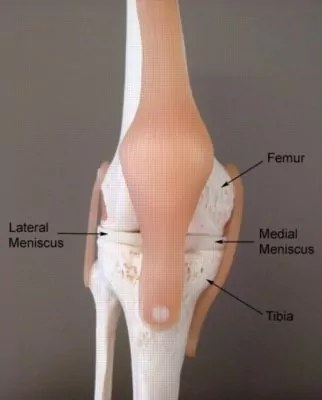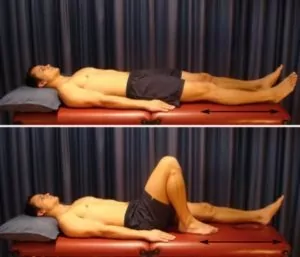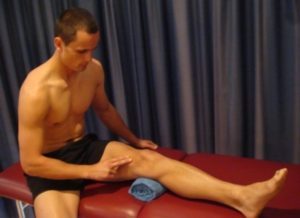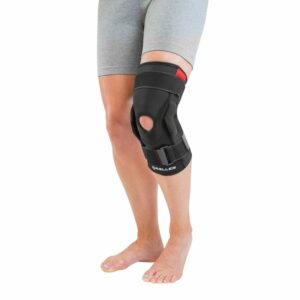Lateral Meniscus Tear
Updated:
(Also known as a Lateral Meniscal Tear, Lateral Cartilage Tear, Lateral Meniscal Dysfunction, Torn Lateral Meniscus, Torn Meniscus, Bucket Handle Tear of the Lateral Meniscus, Cartilage Tear)
What is a lateral meniscus tear?
A lateral meniscus tear is a relatively common injury involving tearing of shock absorbing tissue, known as cartilage, within the knee joint. The lateral meniscus is situated at the outer aspect of the knee joint and when damaged typically causes pain or discomfort in this area.
Anatomy of a lateral meniscus tear
The knee joint is formed by the union of two long bones: the femur (thigh bone) and the tibia (shin bone) (figure 1). Located between the two bone ends are two round shock absorbing discs made of cartilage. These are called the lateral (outer) and medial (inner) meniscus (figure 1).

The medial and lateral meniscus work together as shock absorbers of the knee. Collectively they cushion the impact of the thigh bone on the shin bone during weight bearing activity. In a healthy meniscus, the weight bearing surface is very smooth allowing unobstructed, low friction movement of the femur on the tibia. Occasionally the meniscus can be damaged or torn so that the weight bearing surface is no longer smooth. This typically occurs in association with excessive weight bearing or twisting forces. When this damage occurs to the lateral meniscus, the condition is known as a lateral meniscus tear.
Lateral meniscus injuries occur less frequently than medial meniscus injuries. Sometimes, a lateral meniscus tear may occur in association with damage to other structures of the knee. These may include the collateral ligaments, medial meniscus, patello-femoral joint or cruciate ligaments.
Causes of a lateral meniscus tear
A lateral meniscus tear frequently occurs traumatically. This may be due to excessive twisting or weight bearing forces. Lateral meniscus tears often occur in sports that involve sudden changes of direction or twisting movements (especially in addition to excessive bending or straightening of the knee). These sports may include basketball, netball, soccer, football, snowboarding and skiing. Lateral meniscal tears often occur when the knee is subject to a twisting force whilst the foot is fixed on the ground. This may occur during a tackle or when another player falls across the leg. A forceful jump or landing may also precipitate these injuries.
Lateral meniscal tears also commonly occur in association with gradual wear and tear or overuse. In these situations, repetitive or prolonged twisting or weight bearing forces are often to blame. These forces will eventually cause an injury when they reach a threshold that is beyond what the meniscus can withstand (e.g. excessive distance running). In some often older patients, degenerative changes to the knee joint may be associated with an overuse lateral meniscus injury. In these cases, damage to the lateral meniscus may take place with a reasonably trivial movement.
Signs and symptoms of a lateral meniscus tear
Patients with a lateral meniscus tear often experience a sudden onset of pain at the time of injury. Pain may be sharp or dull and is typically located at the outer aspect, back or front of the knee. Sometimes a tearing sensation or audible sound is heard at the time of injury. Pain is often experienced with weight bearing, change of direction or twisting activities. Symptoms may also increase when squatting, kneeling, climbing stairs, lifting or carrying or walking up or down hills, stairs or on uneven surfaces. In more severe cases, swelling may be present within a few hours after injury or, may develop over the following days. The knee may also feel unstable or weak and may give way, click or lock during certain movements of the knee. Tenderness is also usually experienced upon firmly touching the outer aspect of the knee joint.
In patients with a minor lateral meniscus tear little or no immediate symptoms may be experienced. In these cases, a gradual onset of symptoms may develop over a number of days. This typically occurs in association with excessive twisting or weight bearing forces. In patients with a severe lateral meniscus tear, severe pain and markedly reduced knee range of movement may be experienced. Intermittent clicking, locking, or episodes of the knee giving way may also be present. The patient may also walk with a noticeable limp, or, in some cases, be unable to place weight through the affected knee (and leg) due to pain.
Diagnosis of a lateral meniscus tear
A thorough examination from an experienced physiotherapist is often sufficient to diagnose a lateral meniscus tear. Further investigations such as an MRI or X-ray are sometimes used to confirm diagnosis and / or exclude other knee conditions. In rare cases, an investigative knee arthroscopy may be performed to assist diagnosis. This may particularly be indicated in cases where an MRI has proven inconclusive.
Treatment for a lateral meniscus tear

Members Only ContentBecome a PhysioAdvisor Member to gain full access to this exclusive content. For more details see Become a Member. Already a member? Login Now
Surgery for a lateral meniscus tear
In clinical practise, a small percentage of minor meniscal injuries fail to improve adequately despite appropriate physiotherapy treatment. In these cases, surgery may be indicated to ensure an optimal outcome. Most large meniscal tears, particularly involving a ‘locked’ knee also require surgical intervention.
Surgery for a lateral meniscus tear involves a minimally invasive procedure known as a knee arthroscopy. In this procedure, an orthopaedic surgeon debrides or removes the torn part of the meniscus via 2 small incisions. This ensures the weight bearing surface of the meniscus is smooth allowing unobstructed movement of the knee. Surgery generally aims to preserve as much of the cartilage as possible. This helps to maintain the knee’s shock absorption capacity whilst minimising the likelihood of future degeneration. The treating physiotherapist and doctor will refer to an orthopaedic specialist if surgery may be indicated. This is often the case following a reasonable period of failed conservative treatment. Physiotherapy treatment and rehabilitation is required after surgery to ensure a safe return to activity or sport and an optimal outcome. This should ideally begin prior to surgery to speed recovery.
Prognosis of a lateral meniscus tear
Patients with a minor lateral meniscus tear who undergo appropriate conservative management can typically expect to return to sport or activity in around 2 – 4 weeks. For moderate meniscal tears that are managed with appropriate conservative physiotherapy, return to activity or sport may take 4 – 6 weeks or longer.
Those patients with a minor lateral meniscus tear that undergo arthroscopic surgery can sometimes return to activity or sport within 4 – 6 weeks. However, most surgical repairs (particularly with moderate to severe meniscus tears) usually require a 6 – 8 week period of rehabilitation or longer. In patients with co-existing damage to other knee structures (for example the anterior cruciate ligament), the rehabilitation period may be significantly prolonged. Appropriate treatment and rehabilitation of lateral meniscus injuries is vital, as inappropriate management may lead to the development of osteoarthritis of the knee.
Contributing factors to the development of a lateral meniscus tear
There are numerous factors which may contribute to the development of a lateral meniscal tear. These should be assessed and where possible, corrected with direction from an experienced physiotherapist. These contributing factors may include:
- inappropriate or excessive training or activity
- inadequate recovery periods from training or activity
- poor biomechanics (e.g. flat feet or high arches)
- inadequate warm up
- muscle weakness (especially the quadriceps, gluteals or hamstrings)
- poor fitness
- fatigue
- poor balance
- muscle tightness (especially the quadriceps, hamstrings or calf)
- joint stiffness (particularly of the knee, hip or ankle)
- postural issues
- poor pelvic and core stability
- insufficient rehabilitation following a prior knee injury
Physiotherapy for a lateral meniscus tear
Physiotherapy treatment is essential to hasten healing, reduce the likelihood of injury recurrence and ensure an optimal outcome. This is vital in all patients with a lateral meniscus tear regardless of whether they undergo conservative or surgical management. Physiotherapy may comprise:
- education
- soft tissue massage
- joint mobilization
- dry needling
- electrotherapy
- ice or heat treatment
- the use of crutches
- the use of a knee brace or knee taping
- hydrotherapy
- progressive rehabilitation exercises to restore flexibility, balance and strength (particularly of the VMO muscle)
- activity modification advice
- biomechanical correction (e.g. the use of orthotics)
- anti-inflammatory advice
- Real-Time Ultrasound use to assess and retrain the Vastus Medialis Obliquus (VMO) muscle
- weight loss advice when indicated
- a gradual return to running program
- a gradual return to sport or activity program
For patients with a lateral meniscus tear who undergo surgical management, physiotherapy and rehabilitation should begin prior to surgery. This is vital to minimise pain and swelling, improve flexibility and strength, hasten recovery following surgery and ensure an optimal outcome. Following surgery, physiotherapy treatment and appropriate rehabilitation is essential to hasten return to activity or sport, minimise the likelihood of future recurrence and provide an optimal outcome.
Other intervention for a lateral meniscus tear
A very small percentage of patients with lateral meniscus tears do not improve adequately either conservatively or following surgery. In these cases, the treating physiotherapist or doctor can advise on the best course of management. This may include a second opinion from another experienced physiotherapist, further investigations, the use of certain medication, a corticosteroid injection, or further surgery.
Exercises for a lateral meniscus tear
The following exercises are frequently prescribed to patients with a lateral meniscus tear. The suitability of these exercises should be discussed with your physiotherapist prior to commencement. Generally, they should be performed 3 times daily and only provided they do not cause or increase symptoms.
Your physiotherapist can advise when you can begin the initial exercises and eventually progress to the intermediate and advanced exercises. In general, the addition of exercises should take place provided there is no increase in symptoms.
Initial Exercises
Knee Bend to Straighten
Bend and straighten your knee as far as you can go without pain and provided you feel no more than a mild to moderate stretch (figure 2). Repeat 10 – 20 times provided there is no increase in symptoms.

Static Quadriceps Contraction
Tighten the muscle at the front of your thigh (quadriceps) by straightening your knee and pushing your knee down into a towel (figure 3). Put your fingers on your inner quadriceps (VMO) to feel the muscle tighten during contraction. Hold for 5 seconds and repeat 10 times as hard as possible provided there is no increase in symptoms.

Intermediate Exercises

Members Only ContentBecome a PhysioAdvisor Member to gain full access to this exclusive content. For more details see Become a Member. Already a member? Login Now
Advanced Exercises

Members Only ContentBecome a PhysioAdvisor Member to gain full access to this exclusive content. For more details see Become a Member. Already a member? Login Now
Rehabilitation Protocol for a lateral meniscal tear

Members Only ContentBecome a PhysioAdvisor Member to gain full access to this exclusive content. For more details see Become a Member. Already a member? Login Now
 Physiotherapy products for a lateral meniscus tear
Physiotherapy products for a lateral meniscus tear
Some of the most frequently recommended products by physiotherapists to accelerate recovery from a lateral meniscus tear include:
To purchase appropriate physiotherapy products to accelerate recovery from a lateral meniscus tear click on the relevant link above or visit the PhysioAdvisor Shop.
 Find a Physio for a lateral meniscus tear
Find a Physio for a lateral meniscus tear
Find a physiotherapist in your local region who can treat a lateral meniscus tear.
 More Information for a lateral meniscus tear
More Information for a lateral meniscus tear
- Knee Strengthening Exercises.
- Knee Stretches.
- How to use Crutches.
- Ice or Heat.
- Knee Arthroscopy.
- Return to Running
- Return to Sport
- Why is my Injury Not Improving?
Become a PhysioAdvisor Member

Link to this Page
If you would like to link to this article on your website, simply copy the code below and add it to your page:
<a href="https://physioadvisor.com.au/injuries/knee/lateral-meniscus-tear”>Lateral Meniscus Tear – PhysioAdvisor.com</a><br/>A lateral meniscus tear involves tearing of cartilage tissue in the knee. Learn about the symptoms, causes, treatment, exercises, rehab protocol and more...
Return to the top of Lateral Meniscus Tear.











